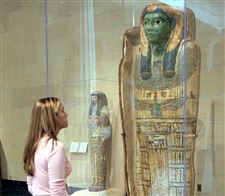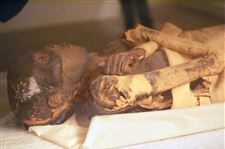https://www.toledoblade.com/A-E/2018/01/28/TMA-mummies-exhibit-opens-next-weekend.html
Toledo Museum of Art mummies exhibit opens next weekend
close-up of one of two mummies on display for the exhibit in 2008.
The Blade/Jetta Fraser
Display explores the allure of Egyptian history
With the Toledo Museum of Art's two ancient Egyptian mummies going back on public display next weekend, professors, egyptologists, and museum experts will attempt to answer a basic question: Why has western civilization maintained a fascination with ancient Egypt — a phenomenon called Egyptomania?
The Mummies: From Egypt to Toledo exhibition opens Saturday and includes not just the two mummified humans brought to Toledo in 1906 by museum founders Florence and Edward Drummond Libbey but more than 90 artifacts or pieces, a film series, and discussions about the appeal of ancient Egypt.
What: The Mummies: From Egypt to Toledo
When: Feb. 3 to May 6.
Where: Toledo Museum of Art, Canaday Gallery
Admission: $10 for non-members, free for members
Related programming
• 2 p.m. Saturday, curator talk, Adam Levine and Mike Deetsch
• 2 p.m. Saturdays, Feb. 7 through May 5, mummy movies, Little Theater
• March 8-10, Flashlight tours: Mummies by Moo-Light (times vary)
• 6 p.m. March 29, Peristyle, Masters Series Lecture, Bob Brier, "Egyptomania: Our Three Thousand Year Obsession with the Land of the Pharaohs"
• 6 p.m., April 19, Peristyle, Salima Ikram, "May They Live Forever: Ancient Egyptian Mummies"
Brier, whose research into ancient Egypt over the last four decades and whose work to mummify a modern-day human cadaver in 1994 earned him the nickname "Mr. Mummy," is one of two experts who will visit the museum to talk about that obsession.
Part of his massive private collection of Egyptomania memorabilia will also be a part of the exhibition.
Visitors will view massive Egyptian-themed posters that informed the public about levitating mummies and other magic sensations in the early 20th century and sheet music that glorified the 1922 discovery by Howard Carter of Tutankhamun's nearly intact tomb (and inaccurately portrayed King Tut as an old man).
The movie trailer from the 1932 film The Mummy with Boris Karloff will loop, and visitors can watch a full-length mummy film at 2 p.m. almost every Saturday during the event.
Nineteenth-century photos documenting Egyptian culture are a key component of the show. Kitschy objects such as Egyptian magic wrinkle cream, necklaces made of scarab images, and lead pencils in the shape of mummies worn by women in Victorian times help tell the tale of enthrallment.
"In the early 20th century, when the Libbeys were in Egypt, although I can't say for certain that the Libbeys were impacted by Egyptomania, I think that it is a reasonable hypothesis that Mrs. Libbey would have seen ads in [Ladies] Home Journal by Palmolive and rejuvenating beauty by using soap associated with ancient Egypt," said Mike Deetsch, director of education and engagement for the museum and co-curator of the show with Adam Levine, museum associate director and curator of ancient art. "Or she would have been exposed to pendants and other jewelry that would have ancient Egypt themes like scarabs, beetles."
Significant events such as Carter's discovery of King Tut's tomb, or the 1798 invasion by Napoleon Bonaparte, who brought with him dozens of scientists and researchers to document Egypt's culture, kept bringing fascination with the African country back to the forefront, Brier said. He also attributes Egyptomania to the country's "sophisticated and spectacular" ancient art.
But the centerpiece of the exhibition, the partially unwrapped mummy believed to be a young priest who lived close to the time of 800 B.C., and the fully wrapped mummy, a laborer estimated to have lived about 100 A.D., are what anchors us in Egyptian culture, Brier said.
"There is no other civilization that I know of that [still] has great temples and the [remains of] people who built them," he said. "I think the reason mummies fascinate people has to do with the desire for immortality. When we look on the face of a mummy, if we knew him 3,000 years ago, we would recognize him. In a way, he really has cheated death, and I think in some ways we are envious of that."
During two excursions to Egypt in 1906 and 1924, the Libbeys purchased objects from antiquities dealer Ralph Blanchard, whose shop in the heart of Cairo offered many of the cultural pieces the couple sought.
Along with statuettes, earthenware vessels, reliefs, and canopic jars (vessels made to hold the internal organs of the deceased), the Libbeys transported the wrapped mummies back to Toledo in 1906. That winter, they formally opened the Egyptian gallery in the museum's first location on Madison Street. The exhibit featured more than 230 ancient Egyptian pieces, according to an excerpt by curator Elaine Altman Evans from Souvenirs and New Ideas: Traveling and Collecting in Egypt and the Near East.

Jessica Buckenmeyer, then a senior from Swanton HS, looks over one of the mummy case displays at the Art Museum.
The Blade
Enlarge | Buy This Image
Today, Egyptian and other international laws would make it impossible to export mummified remains and other ancient relics from the country.
The mummies remained on display in the museum until 1978, at which time the young priest was taken off display for conservation reasons, according to museum officials. The old man remained on public display until 1997.
Since then, the mummies have been back in public view only twice: during the exhibition The Unseen Art of TMA: What's in the Vaults and Why? in 2004 and The Egypt Experience: Secrets of the Tomb from October, 2010, to January, 2012.
In the interims, the human remains are stored in specially designed containers in a climate-controlled room, Deetsch said.
When the Libbeys purchased Toledo's mummies in the early 20th century, a curiosity surrounded them.
An excerpt from Edward Drummond Libbey: American Glassmaker by Quentin Skrabec, Jr., references Libbey and then-museum director George Stevens searching for treasure on one of the mummies, which they reportedly named Willy, and dancing with it around the gallery when the mummies first arrived in Toledo.
In contemporary society, such an act might be seen as ethically questionable, and the inclusion of human remains in a museum exhibition remains controversial.
The cadaver Brier mummified more than 20 years ago, which resulted in the National Geographic special Mr. Mummy, is currently part of a traveling exhibition, Mummies of the World.

A close-up of one of two mummies on display for the exhibit in 2008.
The Blade/Jetta Fraser
Enlarge | Buy This Image
"I don't think there is anything wrong with displaying human remains in museums as long as it's done tastefully and you are not doing it in any sensationalist way," he said. "This is part of an ancient civilization's heritage. Almost all of us who work with mummies would agree that it's absolutely fine to have them on display in museums as long as it's done properly."
For this exhibition, the mummified humans will be the last stop in the quest to understand ancient Egyptian culture, Deetsch said. Museum staffers are asked frequently where the mummies are, and their feedback during the show will be paramount to what the museum does with the old man and young priest in the future, he said.
"The mummies will actually be presented by themselves with no other objects and very little text, because at the end of the day we want people to really reflect on what we can learn from the mummies, should an art museum be displaying human remains, and what, frankly, does it really mean," Deetsch said.
"One of my thoughts is that because thousands of years separate us from ancient Egyptian culture and there has been all of this cultural iconography for hundreds of years, that we don't see these mummies as human remains anymore. We see them as objects of mystery or objects of curiosity.
"The hope is we want people to recognize them as human remains, that these are real people."
The Mummies: From Egypt to Toledo closes May 6.
-- Sent from my Linux system.

No comments:
Post a Comment